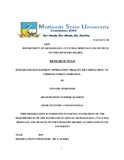Please use this identifier to cite or link to this item:
https://cris.library.msu.ac.zw//handle/11408/4102| Title: | Integrated management approaches “reality or usefulness” at Chirinda forest Zimbabwe. | Authors: | Mabhande, Tinashe | Keywords: | Conservation Intangible heritage Heritage |
Issue Date: | 2015 | Publisher: | Midlands State University | Abstract: | The main focus of this study was to examine the “REALITIES AND USEFULNESS” of using integrated management approaches in the management of Chirinda Forests. Using the Value Driven Approach as a theoretical framework of this study, it stated that cultural heritage management must be based on understanding the site, assessing significance, identification of values, setting policies to retain significance as well as managing heritage according with significance and involving of stakeholders. The theory of Legal Pluralism was also utilised, which advocates the use of pluralistic legal laws in managing cultural heritage sites, in this case the researcher referred to the use of EMA, Parks and Wildlife and Forestry Acts in the management of Chirinda Forest. In achieving the aim of the research, the research adopted a case study research design. Thus the study employed interviews, questionnaires and observations for data collection. This also led to the understanding that the use of integrated management approaches in Zimbabwe was not yet a well-established and a well appreciated phenomenon which is evidenced by lack of stakeholder participation, engagement and empowerment in heritage management. On the other hand the research found out that local communities are being obstructed from active participation in heritage management at Chirinda Forest. These included that state based agencies does not value the contribution of local communities in heritage management, lack of policies and guidelines which encompass the inclusion of local communities in heritage management within an integrated framework. Recommendations were also given which included the need to come up with a holistic inclusion of all stakeholders in heritage management especially local communities, to have balance of power in decision making. In order to achieve proper conservation of cultural heritage stakeholders must operate at the same uniform level. | URI: | http://hdl.handle.net/11408/4102 |
| Appears in Collections: | Ba Archaeology, Cultural Heritage And Museum Studies Honours Degree |
Files in This Item:
| File | Description | Size | Format | |
|---|---|---|---|---|
| MABHANDET FINAL PROJECT.pdf | Full Text | 1.22 MB | Adobe PDF |  View/Open |
Page view(s)
120
checked on Feb 26, 2025
Download(s)
48
checked on Feb 26, 2025
Google ScholarTM
Check
Items in MSUIR are protected by copyright, with all rights reserved, unless otherwise indicated.


